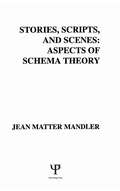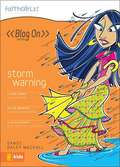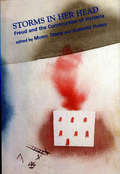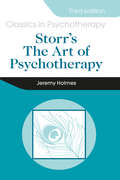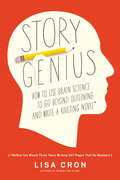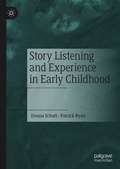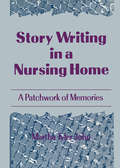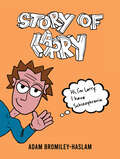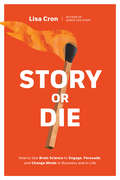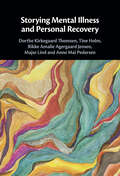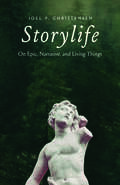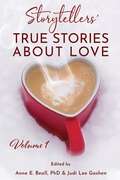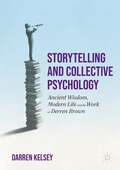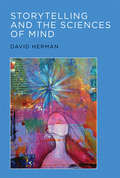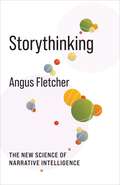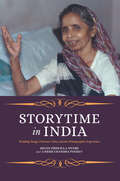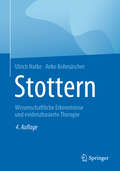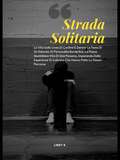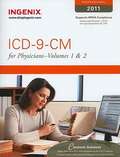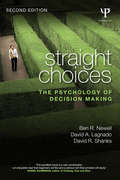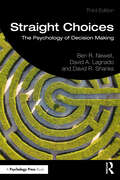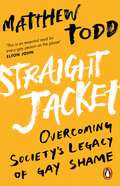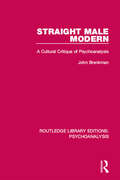- Table View
- List View
Stories, Scripts, and Scenes: Aspects of Schema Theory (Distinguished Lecture Series)
by J. M. MandlerFirst published in 1984. Routledge is an imprint of Taylor & Francis, an informa company.
Storm Warning (Faithgirlz! Blog On #8)
by Dandi Daley MackallStorm Novelo can't understand why she's messing up more now than before she became a Christian. Believing she's at least partly to blame for her dad's depression, Storm determines to make him proud by joining the Quiz Bowl team, a move that pits her against Cameron Worthington the Third and teammates who'll do everything they can to see her fail.
Storms in Her Head
by Muriel DimenA century after it was written, Breuer and Freudís Studies on Hysteria continues to challenge. In Storms in Her Head, many of todayís most renowned psychoanalysts and cultural theorists revisit the cases it contains, reflecting on how six suffering women continue to engage us with problems of theory and practice. Each author offers a major contribution to current psychoanalytic thinking about culture and its influence on the mind, the body and clinical process. Storms in Her Head offers an eclectic and lively set of opinions on Freud, his hysterical patients, and the psychoanalytic journey they began together.
Storr's Art of Psychotherapy 3E
by Jeremy Holmes Charles P. NemethHighly Commended, BMA Medical Book Awards 2013Sensitively updated and revised for modern practice, Anthony Storr's legendary work continues to be an indispensible introductory text for aspiring psychotherapists.Professor Jeremy Holmes, a friend and colleague of Anthony Storr's and himself a leading psychotherapist, has updated this accessible and h
Story Genius: How to Use Brain Science to Go Beyond Outlining and Write a Riveting Novel (Before You Waste Three Years Writing 327 Pages That Go Nowhere)
by Lisa CronFollowing on the heels of Lisa Cron's breakout first book, Wired for Story, this writing guide reveals how to use cognitive storytelling strategies to build a scene-by-scene blueprint for a riveting story. It's every novelist's greatest fear: pouring their blood, sweat, and tears into writing hundreds of pages only to realize that their story has no sense of urgency, no internal logic, and so is a page one rewrite. The prevailing wisdom in the writing community is that there are just two ways around this problem: pantsing (winging it) and plotting (focusing on the external plot). Story coach Lisa Cron has spent her career discovering why these these methods don't work and coming up with a powerful alternative, based on the science behind what our brains are wired to crave in every story we read (and it's not what you think). In Story Genuis Cron takes you, step-by-step, through the creation of a novel from the first glimmer of an idea, to a complete multilayered blueprint--including fully realized scenes--that evolves into a first draft with the authority, richness, and command of a riveting sixth or seventh draft.From the Trade Paperback edition.
Story Listening and Experience in Early Childhood
by Patrick Ryan Donna SchattThis book shows connections between oral story listening and unique, enduring educational effects in and outside of the classroom. Using scientific studies and interviews, as well as personal observations from more than thirty years in schools and libraries, the authors examine learning outcomes from frequent story listening. Throughout the book, Schatt and Ryan illustrate that experiencing stories told entirely from memory transforms individuals and builds community, affecting areas such as reading comprehension, visualization, focus, flow states, empathy, attachment, and theory of mind.
Story Writing in a Nursing Home: A Patchwork of Memories
by Martha A JohnBased on the belief that older people have good stories to tell, Story Writing in a Nursing Home was developed as part of a volunteer teaching service to a nursing home. Graduate students who were learning to teach this special population conducted story writing activities with older adults and found that even the frail elderly who are confined to nursing centers provided a unique perspective about events that emphasize the lasting verities in life. The idea of a patchwork was derived from one of the lessons taught and was suggested by one of the older participants who said, “We’re sort of like a patchwork quilt.” The information, memories, and humor the elderly see in situations is worth recording. In addition, Story Writing in a Nursing Home emphasizes the way to develop the mental stimulation that is so important for physical well being. This sensitive and insightful book provides a lesson plan outline and the type of content that was used as an example. It also provides a running commentary in the form of a diary that tells how to begin a teaching program for nursing center residents. Students and professionals interested in implementing a similar program can use these ideas for planning and for organizing the use of student help to better serve the population. Fascinating reading, this book includes stories by frail elderly people, lesson plans, tips on working with administrators in a nursing center, and reasons for providing instruction. Teachers, volunteers, librarians, gerontology/sociology students, and others concerned with the well-being of the elderly will refer often to this instructive volume.
Story of Larry
by Adam Bromiley-HaslamBeneath the veneer of simplicity lies a profound exploration of the mind’s deepest quandaries. Journey with me through relentless internal battles, where the only opponent is oneself. Confront the pervasive dread of solitude and the challenges of discerning reality from illusion. If these pages resonate with even a single reader, every struggle shared will have been worth the journey. Discover a narrative that seeks connection in our shared human experience.
Story or Die: How to Use Brain Science to Engage, Persuade, and Change Minds in Business and in Life
by Lisa Cron&“A practical, heartfelt manual for anyone who needs to change minds and actions. Lisa Cron shares the art of practical empathy with leaders who care enough to make a difference.&”—Seth Godin, author of The Practice A step-by-step guide to using the brain&’s hardwired need for story to achieve any goal, from the author of Wired for Story Whether you&’re pitching a product, saving the planet, or convincing your kids not to text and drive, story isn&’t just one way to persuade. It&’s the way. It&’s built into the architecture of the brain, and has been since early humans gathered around the camp fire, trying to figure out how to outsmart the lion next door.In Story or Die, story coach Lisa Cron sets out to decode the power of story, first by examining how the brain processes information, translates it into narrative, and then guards it as if your life depends on it. Armed with that insight, she focuses on how to find your real target audience and then pinpoint their hidden resistance. Finally, she takes you, step-by-step, through the creation of your own story, one that allows your audience to overcome their resistance and take up your call to action, not because you told them to, but because they want to.That is the power of story. Use it wisely.
Storying Mental Illness and Personal Recovery
by Dorthe Kirkegaard Thomsen Tine Holm Rikke Jensen Majse Lind Anne Mai PedersenThis book contains excerpts of life stories from 118 individuals diagnosed with schizophrenia, bipolar disorder, borderline personality disorder, and major depressive disorder. This library of personal narratives, heavily reproduced and quoted throughout the text, presents a composite image of the ways in which narrative identity can be affected by mental illness while also being a resource for personal recovery. Those researching, studying or practicing in mental health professions will find a wealth of humanizing first-person perspectives on mental illness that foster perspective-taking and aid patient-centered treatment and study. Researchers of narrative psychology will find a unique set of life stories synthesized with existing literature on identity and recovery. Moving towards intervention, the authors include a 'guide for narrative repair' with the aim of healing narrative identity damage and fostering growth of adaptive narrative identity.
Storylife: On Epic, Narrative, and Living Things
by Joel P. ChristensenFrom Homer’s epics to mainstream news, stories have lives of their own—and humans may not always control the narratives we create Combining ancient epic and myth with analogies from biology and the natural world, Joel P. Christensen explores the creative process and how narratives develop. This bold work urges readers to treat narratives as living things with their own agency in the world. Christensen starts by using Homeric epic to explore the way language and meaning develop alongside audiences in complex ecosystems and then moves through storytelling in the ancient Mediterranean over a thousand years. In this study, which ranges from the evolution of narratives to viral ideas, and to the dangerous side of stories in mass shootings and war, we see how narratives function as independent entities with consequences that cause lasting harm. Connecting his argument to the present day, Christensen addresses contemporary cultural panics, including AI and ChatGPT, “post-truth” or alt-facts in the digital age, and free speech and cancel culture. Storylife invites readers to rethink human creativity, the importance of collective actions, and the lives we build together with and against narrative. In an age rife with misinformation, it is time to reconsider how much control we have over stories and how to educate ourselves once we acknowledge the power that narrative exerts over us.
Storytellers' True Stories about Love Volume 1
by Anne E. Beall & Judi Lee GoshenThe stories in this collection explore love in all its permutations: love for romantic partners, children, parents, friends, pets, careers, and passionate interests. In one story, the author describes a visit to Cuba and entering a building under construction to experience a part of her beloved father's history. In another, a mother recounts her family's vigil as her child undergoes lifesaving surgery. Author Maureen Riley share how salsa dancing rescued her after a painful divorce.
Storytelling and Collective Psychology: Ancient Wisdom, Modern Life and the Work of Derren Brown
by Darren KelseyThis book examines the work of psychological illusionist Derren Brown to understand the significance of storytelling and ancient philosophy in our society. Reflecting on the social disconnection and political polarisation of recent times, Darren Kelsey considers how we can rebuild a sense of collective cohesion and common good, weaving together contemporary psychology with ancient Stoicism to cut through the noise of modern life. Kelsey shows that Brown is more than a stage performer: he’s an enlightened magician who offers us guidance for navigating the challenges life throws at us, using his skills and wisdom to help us better understand ourselves and enable human flourishing. In this rigorous examination of Brown’s work, Kelsey makes a compelling case for paying closer attention to our personal, cultural and political stories and beliefs to help create a better future – for ourselves, our communities, and the planet.
Storytelling and Other Activities for Children in Therapy
by Johanna Slivinske Lee SlivinskeA comprehensive collection of hundreds of thought-provoking stories and activities for use in the treatment of children confronting difficult situations Storytelling and Other Activities for Children in Therapy provides professionals with the knowledge, insight, and tools to help children (ages 6 to 12) and their families work through their treatment issues using storytelling and other activities. This invaluable guide includes helpful activity sheets that gradually progress through four levels of inquiry, representing readiness for self-disclosure. Imaginative and easy-to-use, the stories and activities in this book are tied to relevant practice issues, including: Illness and disability School issues Anger and behavioral issues Social adjustment and shyness Divorce and parental separation Domestic violence Community violence Trauma and child abuse Substance abuse Death With an accompanying website allowing therapists to personalize and print stories as well as activity sheets to meet their needs and those of their clients, Storytelling and Other Activities for Children in Therapy is an important tool in easing the pain of emotionally hurt children towards a discovery of their inner strengths and resilience for life. These resources can be accessed at www. wiley. com/go/slivinske.
Storytelling and the Sciences of Mind
by David HermanAn transdisciplinary exploration of narrative not just as a target for interpretation but also as a means for making sense of experience itself.With Storytelling and the Sciences of Mind, David Herman proposes a cross-fertilization between the study of narrative and research on intelligent behavior. This cross-fertilization goes beyond the simple importing of ideas from the sciences of mind into scholarship on narrative and instead aims for convergence between work in narrative studies and research in the cognitive sciences. The book as a whole centers on two questions: How do people make sense of stories? And: How do people use stories to make sense of the world? Examining narratives from different periods and across multiple media and genres, Herman shows how traditions of narrative research can help shape ways of formulating and addressing questions about intelligent activity, and vice versa.Using case studies that range from Robert Louis Stevenson's Dr Jekyll and Mr Hyde to sequences from The Incredible Hulk comics to narratives told in everyday interaction, Herman considers storytelling both as a target for interpretation and as a resource for making sense of experience itself. In doing so, he puts ideas from narrative scholarship into dialogue with such fields as psycholinguistics, philosophy of mind, and cognitive, social, and ecological psychology. After exploring ways in which interpreters of stories can use textual cues to build narrative worlds, or storyworlds, Herman investigates how this process of narrative worldmaking in turn supports efforts to understand—and engage with—the conduct of persons, among other aspects of lived experience.
Storythinking: The New Science of Narrative Intelligence (No Limits)
by Angus FletcherEvery time we think ahead, we are crafting a story. Every daily plan—and every political vision, social movement, scientific hypothesis, business proposal, and technological breakthrough—starts with “what if?” Linking causes to effects, considering hypotheticals and counterfactuals, asking how other people will react: these are the essence of narrative. So why do we keep overlooking story’s importance to intelligence in favor of logic?This book explains how and why our brains think in stories. Angus Fletcher, an expert in neuroscientific approaches to narrative, identifies this capacity as “storythinking.” He demonstrates that storythinking is fundamental to what makes us human. Artificial intelligence can perform symbolic logic, rational deduction, and mathematical calculation, but it is incapable of deliberating in narrative. Drawing on new research in neuroscience and narrative theory, Fletcher explores the nature of imagination, innovation, and creativity. He provides concise answers to big questions: How does storythinking work? Why did it evolve? How can it misfire? What problems can it solve?Revealing the significance of storythinking from science to business to philosophy, this book also provides ways for readers to harness its power to script better tomorrows.
Storytime in India: Wedding Songs, Victorian Tales, and the Ethnographic Experience
by Umesh Chandra Pandey Helen Priscilla MyersAn American ethnomusicologist and her Indian collaborator recount their experiences researching Bhojpuri wedding songs in India.Stories are the backbone of ethnographic research. During fieldwork, subjects describe their lives through stories. Afterward ethnographers come home from their journeys with stories of their own about their experiences in the field.Storytime in India is an exploration of the stories that come out of ethnographic fieldwork. Helen Priscilla Myers and Umesh Chandra Pandey examine the ways in which their research collecting Bhojpuri wedding songs became interwoven with the stories of their lives, their work together, and their shared experience reading The Eustace Diamonds by Anthony Trollope. Moving through these intertwined stories, the reader learns about the complete Bhojpuri wedding tradition through songs sung by Gangajali and access to the original song recordings and their translations. In the interludes, Pandey reads and interprets The Eustace Diamonds, confronting the reader with the ever-present influence of colonialism, both in India and in ethnographic fieldwork. Interwoven throughout are stories of the everyday, highlighting the ups and downs of the ethnographic experience.Storytime in India combines the style of the Victorian novel with the structure of traditional Indian village tales, in which stories are told within stories. This book questions how we can and should present ethnography as well as what we really learn in the field. As Myers and Pandey ultimately conclude, writers of scholarly books are storytellers themselves and scholarly books are a form of art, just like the traditions they study.
Stottern: Wissenschaftliche Erkenntnisse und evidenzbasierte Therapie
by Ulrich Natke Anke KohmäscherIn diesem Buch erhalten Sie einen Überblick über den wissenschaftlichen Stand und die aktuellen Behandlungsmethoden der Redeflussstörung Stottern. Die Häufigkeit von Stottern, Erscheinungsformen, Theorien zu den Ursachen, Diagnostik sowie Möglichkeiten der Therapie bei Kindern und Erwachsenen werden nachvollziehbar, praxisnah und auf dem neuesten Stand der Forschung dargestellt: Sprach- und Sprechstörungen, Epidemiologie und Phänomenologie, Entwicklungsverlauf und Variabilität, Ätiologie, Pathophysiologie, Diagnostik und TherapiemethodenDie Autoren engagieren sich in Lehre und Forschung und ermöglichen einen rationalen Zugang zu der verbreiteten Störung. Umfangreiche Literaturangaben ermöglichen eine vertiefende Lektüre in der Ausbildung und im Studium.Neu in der 4. Auflage: Komplett überarbeitet, aktualisiert und erweitert um folgende Themen: Mehrsprachigkeit, Exekutivfunktionen und Auswirkungen im Lebensverlauf stotternder Menschen. Das Buch ist für angehende wie für erfahrene Logopäden und Sprachtherapeuten unverzichtbar, die stotternde Menschen behandeln, und für Psychologen, Psychotherapeuten und Ärzte ein wertvolles Nachschlagewerk.
Strada Solitaria: La Vita Sulla Linea Di Confine E Dentro La Testa Di Un Disturbo Di Personalità Borderline
by Linsy B.Questo libro vi farà piangere. Nessun libro farà appello alla vostra emozione e catturerà ciò che la persona con BPD attraversa quotidianamente, come fa questo libro. Per chi è questo libro? Se stai avendo una crisi d'identità anche se sai che non dovresti, allora questo libro è per te. Se tutti intorno a te sembrano vivere una vita normale mentre la tua sembra totalmente incasinata, ti dico, amico mio, che non potresti trovare un libro migliore che ti capisca come fa questo libro. Se hai una persona cara le cui azioni e reazioni sembrano frustrarti, allora leggi questo libro per capire cosa succede veramente nella testa di una persona con BPD. Raccomanda questo libro anche a chiunque si interroghi su come reagisci alle azioni e trova difficile rendersi conto che tu stesso sei una vittima. Il libro Se sei una persona con BPD e ti sei mai sentito solo, come l'unica persona che soffre di una crisi di non sapere chi è, chiedendoti perché ti senti così vuoto, così sfigato, insicuro e indesiderabile. Questo libro spiega cosa può succedere nella vita di una persona con disturbo borderline di personalità in ogni giorno tipico della sua vita, usando esperienze di vita reale. Le esperienze vi diranno come alcune persone con BPD reagiscono quando credono che stanno per essere scaricate e abbandonate e cosa fanno a riguardo. Mostrerà anche come stanno alcune altre persone con BPD quando si sentono vuote nel loro nucleo interno. Imparerete anche le tre emozioni che una persona con BPD deve affrontare quotidianamente mentre cerca di gestire le azioni impulsive e non impulsive. Una persona con BPD che legge questo libro noterà rapidamente dall'inizio del libro che i suoi sentimenti sono stati finalmente catturati correttamente da qualcuno abbastanza empatico da cercare di capire cosa succede nella testa di una persona con un disturbo borderline di personalità. Dovrebb
Straight
by Hanne BlankA sweeping history of heterosexuality—from its origins in nineteenth-century Germany to the court cases and controversies of today. Heterosexuality is not a fact of nature, it’s a nineteenth-century invention, only about as old as the traffic light. In this surprising chronicle, historian Hanne Blank digs deep into the past of sexual orientation while simultaneously exploring its contemporary psyche. Illuminating the hidden patterns in centuries of events and trends, Blank shows how culture creates and manipulates the ways we think about and experience desire, love, and relationships between men and women. Ranging from Henry VIII to testicle transplants, Disneyland to sodomy laws, and Moby Dick to artificial insemination, the history of heterosexuality turns out to be anything but straight or narrow. With an eclectic scope and fascinating detail, Straight tells the eye-opening story of a complex and often contradictory man-made creation that is all too often assumed to be an irreducible fact of biology.
Straight Choices: The Psychology of Decision Making
by Ben R. Newell David A. Lagnado David R. ShanksShould I have this medical treatment or that one? Is this computer a better buy than that one? Should I invest in shares or keep my money under the bed? We all face a perplexing array of decisions every day. Thoroughly revised and updated throughout, the new edition of Straight Choices provides an integrative account of the psychology of decision-making, and shows how psychological research can help us understand our uncertain world. Straight Choices emphasises the relationship between learning and decision-making, arguing that the best way to understand how and why decisions are made is in the context of the learning and knowledge acquisition which precedes them, and the feedback which follows. The mechanisms of learning and the structure of environments in which decisions are made are carefully examined to explore their impact on our choices. The authors then consider whether we are all constrained to fall prey to cognitive biases, or whether, with sufficient exposure, we can find optimal decision strategies and improve our decision making. Featuring three completely new chapters, this edition also contains student-friendly overviews and recommended readings in each chapter. It will be of interest to students and researchers in cognitive psychology, behavioral economics, and the decision sciences, as well as anyone interested in the nature of decision making.
Straight Choices: The Psychology of Decision Making
by Ben R. Newell David A. Lagnado David R. ShanksStraight Choices provides a fascinating introduction to the psychology of decision making, enhanced by discussion of relevant examples of decision problems faced in everyday life. Thoroughly revised and updated throughout, this edition provides an integrative account of the psychology of decision-making and shows how psychological research can help us understand our uncertain world. The book emphasizes the relationship between learning and decision-making, arguing that the best way to understand how and why decisions are made is in the context of the learning and knowledge acquisition which precedes them, and the feedback which follows. The mechanisms of learning and the structure of environments in which decisions are made are carefully examined to explore their impact on our choices. The authors then consider whether we are all constrained to fall prey to cognitive biases, or whether, with sufficient exposure, we can find optimal decision strategies and improve our decision making. This edition highlights advances made in judgment and decision making research, with additional coverage of behavioral insights, nudging, artificial intelligence, and explanation-based decision making. Written in a non-technical manner, this book is an essential read for all students and researchers in cognitive psychology, behavioral economics, and the decision sciences, as well as anyone interested in the nature of decision making.
Straight Jacket
by Matthew Todd'This is an essential read for every gay person on the planet' - Elton John'A really brilliant and moving read for everybody, especially LGBTQI+ people' - Olly Alexander, star of It's A SinStraight Jacket is a revolutionary clarion call for gay men, the wider LGBT community, their friends and family. Part memoir, part ground-breaking polemic, it looks beneath the shiny facade of contemporary gay culture and asks if gay people are as happy as they could be - and if not, why not? Meticulously researched, courageous and life-affirming, Straight Jacket offers invaluable practical advice on how to overcome a range of difficult issues. It also recognizes that this is a watershed moment, a piercing wake-up-call-to-arms for the gay and wider community to acknowledge the importance of supporting all young people - and helping older people to transform their experience and finally get the lives they really want.WINNER BOYZ BEST LGBT BOOK 2017SHORTLISTED FOR THE POLARI BOOK PRIZE 2017'Insightful, inclusive, clever and engaging' - Jeremy Langmead'Utterly brilliant' - The Guardian
Straight Male Modern: A Cultural Critique of Psychoanalysis (Routledge Library Editions: Psychoanalysis)
by John BrenkmanMajor psychoanalytic thinkers from Freud to Ricoeur to Lacan considered the Oedipus complex the key to explaining the human psyche and human sexuality, even culture itself. But, in fact, they were merely theorizing males. In this title, originally published in 1993, the author reassesses the benchmark concepts of Freudian thought, building on feminist criticisms of psychoanalysis and the new history of sexuality. The psychoanalytic questions become political questions: How do the norms of heterosexuality and masculinity themselves emerge within modern society and culture? How do the institutions of compulsory heterosexuality and modern patriarchy shape identity and desire? What make heterosexuality compulsory in our society? Brenkman argues that the larger social world is part and parcel of the Oedipus complex. He challenges psychoanalysis to reinvent its cultural project, as a therapeutics and an ethics, by recovering the moral-political dimension in its approach to family, sexuality and gender. Straight Male Modern casts a new light on psychoanalysis’s contribution to modern life, revealing the richness of the Freudian tradition’s encounter with modern politics and culture, and the poverty of its response.
Straight Science? Homosexuality, Evolution and Adaptation: Homosexuality, Evolution And Adaptation
by Jim McKnightA genetic basis for homosexuality has been all but proved, yet Darwinism, the most widely accepted evolutionary theory, emphasises successful reproduction. How do we explain a lifetime preference for non-reproductive sex? Whilst social constructionism offers explanations in terms of social learning and cultural preferences, the body of evidence for a genetic predisposition to homosexuality grows. Social learning argues that homosexual sex is merely misdirected and therefore futile, but far from dying out it continues through the ages and is found in different cultures. What if there was an evolutionary advantage to homosexuality? Straight Science? Homosexuality, Evolution and Adaptation dares to ask such questions.
